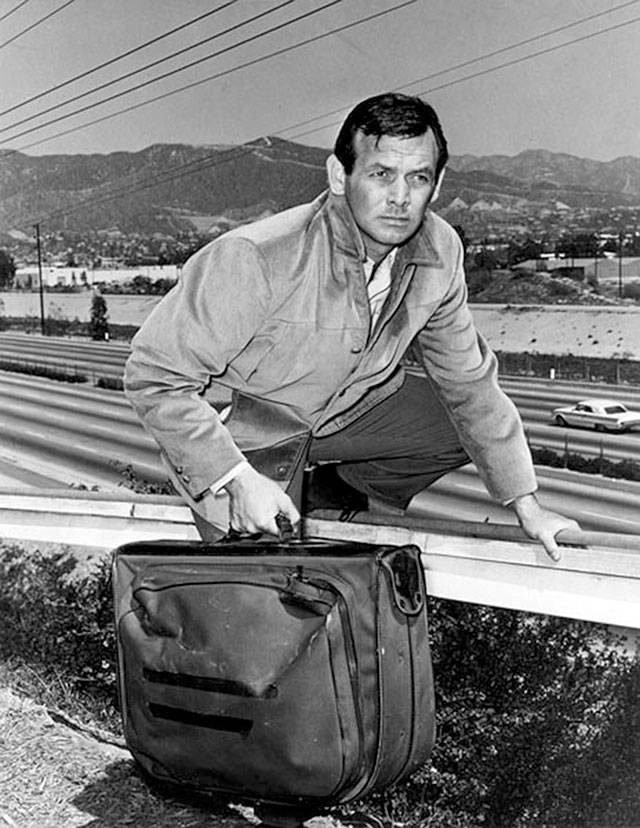By Stephen Battaglio / Los Angeles Times
Fifty years ago, “The Fugitive” stopped running. The end of the pursuit also gave TV its first lesson in figuring out how to say goodbye.
The ABC series starring David Janssen as Richard Kimble, the physician wrongly convicted of killing his wife, was one of the best-loved of the 1960s and the basis of the hit 1993 theatrical feature featuring Harrison Ford as well as a short-lived CBS remake in 2000 starring Tim Daly and Mykelti Williamson and partially shot in Everett.
Before the finale of “The Fugitive,” watched by a then-record audience of 78 million viewers on Aug. 29, 1967, there had never been a big planned send-off to a popular network TV show that provided a massive communal experience for fans.
And therein lies a tale.
For four seasons, “The Fugitive” found the hunted Kimble fleeing to a different place each week, adopting aliases and taking on menial jobs while eluding Lt. Philip Gerard (Barry Morse), the obsessed detective from whom Kimble escaped en route to his execution. Kimble was also hell-bent on proving that Fred Johnson (William Raisch), the mysterious one-armed man he saw leaving his home on the night his wife, Helen, was murdered, was the culprit.
The role of Kimble made Janssen one of TV’s biggest stars. He was on-screen nearly every minute, often in fight scenes and frequently on the run. Even though the show was one of ABC’s most popular — scoring an outstanding drama series Emmy in 1966 — the actor made it known in the fourth season that he had had enough of the drama’s grueling production schedule and desired a film career.
Once ABC announced in winter 1967 that “The Fugitive” was in its final season, Leonard Goldberg, a network programming executive at the time, remembered how friends would ask him how Kimble’s journey would wrap up.
“I said, ‘Well, it’s going to end — it will be over like all other television shows,’” recalled Goldberg, currently the executive producer of “Blue Bloods” on CBS. “We hadn’t planned on ending it.”
Ed Robertson, author of “The Fugitive Recaptured,” said the show’s creator, Roy Huggins, envisioned a conclusion to the cat-and-mouse triangle of Kimble, Gerard and Johnson. But Huggins was not involved in the show beyond selling the idea. There was no road map for resolution. Other long-running series of the time simply went away quietly without tying up loose ends.
Even with its recurring stories involving Gerard, the one-armed man and Kimble’s family, “The Fugitive” was not a serialized drama. The formula was primarily self-contained stories. Continuity was a low priority — many actors cast as guest stars appeared many times in different roles.
Goldberg remembers hearing from his ABC bosses that the audience had no interest in how Kimble’s personal story ended. But he argued that fans had become emotionally involved with the overarching plot lines. Young viewers in the turbulent 1960s were attracted to the anti-establishment undertones in Kimble’s continued evasion of law enforcement — a device that one ABC executive had believed was “un-American” when the show was first pitched.
Said Goldberg, “‘I said, “Our viewers invested four years with Richard Kimble. He’s become real to them. And they want to know what happens to him.”’”
Complicating the situation were business concerns over how a resolution to the story would damage the market for repeats and syndication.
Quinn Martin, the producer of the series, was already seeing $500,000 a year go away with its cancellation. He was counting on a bounty from the sale of episodes to local TV stations. “The Fugitive,” which aired in 69 countries, was also ABC’s most popular and lucrative property overseas. (Janssen said he was frequently quizzed about Kimble wherever he went on vacation in Europe.)
Martin ultimately agreed that fans deserved a finale, and a script was quickly written. But the network, wanting to make sure ratings for repeats would hold up over the summer, waited to air the two-part story, titled “The Judgment,” in the last two weeks of August.
Goldberg also believed the farewell would help promote ABC’s fall lineup.
In the episodes, Gerard learns of the arrest of Johnson for an assault he committed in a Los Angeles topless bar. A news wire service story about the crime is planted, luring the on-the-lam Kimble to police headquarters, where Johnson is being held (much of the episode’s location work was filmed in downtown Los Angeles). But a witness to Helen Kimble’s murder — a panicked war hero neighbor too ashamed to come forward after failing to help her — secretly posts bail for Johnson.
That development eventually leads to a chase back to the scene of the crime in Kimble’s Indiana hometown, and the good doctor is eventually exonerated after a dramatic, western-style showdown filmed in the former Pacific Ocean Park at the Santa Monica Pier.
Part 2 of “The Judgment” was seen in 72 percent of the homes using television on the night it aired against scant competition on CBS and NBC. The audience size remained a Nielsen record until November 1980, when it was topped by the “Who Shot J.R.?” episode of “Dallas.”
In the pre-Internet era of 1967, there was no online obsessing or major spoilers revealed about the ending. Janssen was known for joking that “The Fugitive” would conclude with Kimble relaxing on a desert island and removing a prosthetic arm, showing that he had murdered Helen. (“I killed her, Joey — she talked too much,” Janssen cracked to ABC late-night talk-show host Joey Bishop.)
The actual reveal was kept under wraps under Martin’s orders. ABC did not provide a screening of the finale for TV critics.
Some journalists were not impressed. “Hardly worth waiting four years for,” Variety wrote.
Talk to us
> Give us your news tips.
> Send us a letter to the editor.
> More Herald contact information.

























